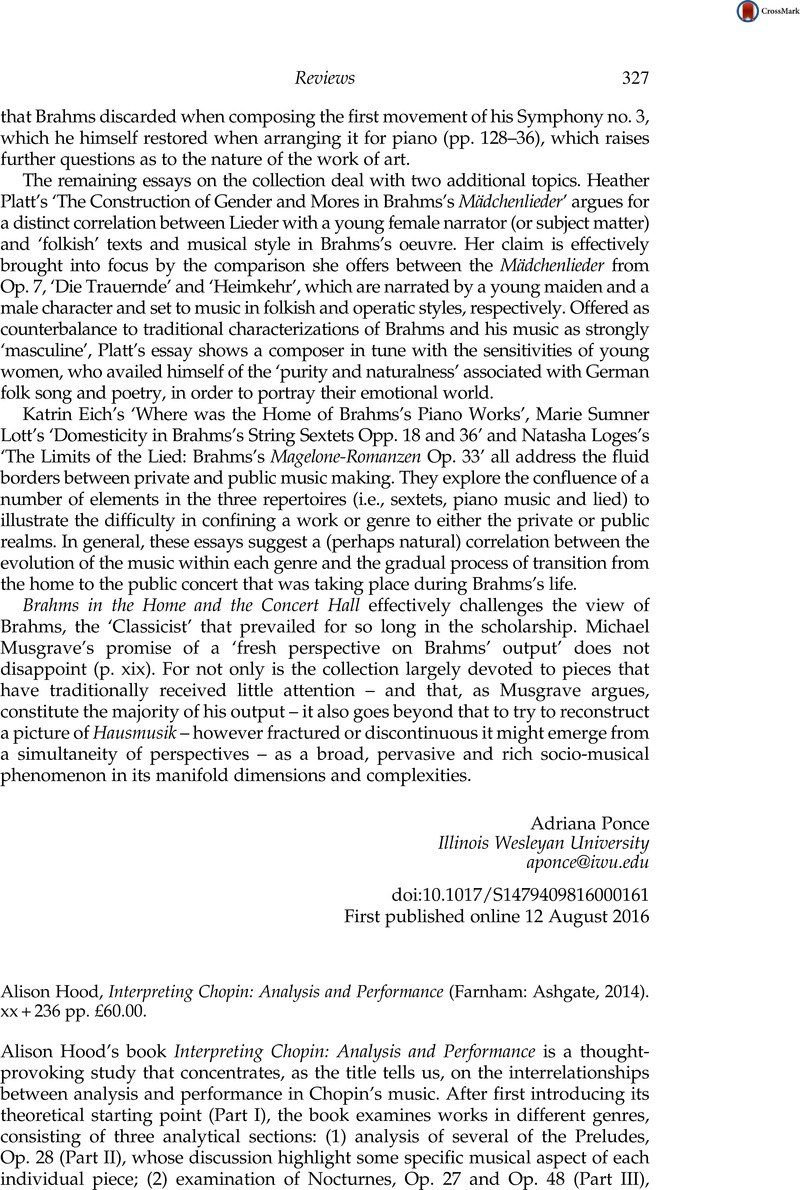No CrossRef data available.
Published online by Cambridge University Press: 30 August 2016

1 The most comprehensive source for Heinrich Schenker’s mature theory and analytical technique is his Free Composition (Der freie Satz [1935]), trans. and ed. Ernst Oster (New York: Longman 1979).
2 See Schenker, Heinrich, Free Composition, p. 99 Google Scholar.
3 See Larson, Steve, ‘Musical Forces and Melodic Patterns’, Theory and Practice 22/3 (1997–1998): 55–71 Google Scholar.
4 Cadwallader, Allen, ‘Prolegomena to a General Description of Motivic Relationships in Tonal Music’, Intégral 2 (1988): 1–33 Google Scholar.
5 Burkhart, Charles, ‘Schenker’s “Motivic Parallelisms”’, Journal of Music Theory 22/2 (1978): 145–175 CrossRefGoogle Scholar.
6 Cohn, Richard, ‘The Autonomy of Motives in Schenkerian Accounts of Tonal Music’, Music Theory Spectrum 14/2 (1992): 150–170 CrossRefGoogle Scholar.
7 In a classic essay, David Lewin clearly illustrates the significance of context in elucidating the function of individual musical events. If the musical and analytical contexts are not specified, we cannot really define, Lewin argues, the function of individual musical events. See Lewin, , ‘Music Theory, Phenomenology, and Modes of Perception’, Music Perception 3/4 (1986): 327–392 CrossRefGoogle Scholar.
8 See Larson, Steve, ‘Strict Use of Analytic Notation’, Journal of Music Theory Pedagogy 10 (1996): 37–77 Google Scholar.
9 See Krebs, Harald, ‘Some Early Examples of Tonal Pairing: Schubert’s “Meeres Stille” and “Der Wanderer”’, in The Second Practice of Nineteenth-Century Tonality, ed. William Kinderman and Harald Krebs (Lincoln and London: University of Nebraska Press, 1996): 17–33 Google Scholar.
10 See Almén, Byron, A Theory of Musical Narrative (Bloomington: Indiana University Press, 2008)Google Scholar.
11 See Rothstein, William, ‘Analysis and the Act of Performance’, in The Practice of Performance: Studies in Musical Interpretation, ed. John Rink (Cambridge: Cambridge University Press, 1995): 217–240 CrossRefGoogle Scholar.
12 See Rothstein, William, ‘Like Falling off a Log: Rubato in Chopin’s Prelude in A-flat Major (op. 28, no. 17)’, Music Theory Online 11/1, www.mtosmt.org/issues/mto.05.11.1/mto.05.11.1.rothstein.html Google Scholar (Accessed 21 May 2015.)
13 See Lester, Joel, ‘Performance and Analysis: Interaction and Interpretation’, in The Practice of Performance: Studies in Musical Interpretation, ed. John Rink (Cambridge: Cambridge University Press, 1995): 197–216 CrossRefGoogle Scholar.
14 See McCreless, Patrick, ‘Analysis and Performance: A Counterexample?’, Dutch Journal of Music Theory 14/1 (2009): 1–16 Google Scholar.
15 In the French first edition of the Nocturne, there is a fleeting semiquaver G at the end of bar 16. However, this brief G is not sufficient to transform the chord into a root-position sonority.
16 Schachter, Carl, Unfoldings: Essays in Schenkerian Theory and Analysis, ed. Joseph N. Straus (New York: Oxford University Press, 199), p. 137 Google Scholar.
17 The sentence in bars 9–16 is not an archetypal one, as William Caplin would describe it (see Caplin, William, Classical Form: A Theory of Formal Functions for the Instrumental Music of Haydn, Mozart, and Beethoven (New York: Oxford University Press, 1998): 35–48 Google Scholar); most importantly for us, the presentation phrase is not tonic prolongational and the continuation phrase does not end in a cadence. Owing to limitations of space, it is not possible to here address aspects of nineteenth-century sentences.
18 Such non-congruence of temporal functions is not uncommon in Chopin; for an analysis of the Nocturne, Op. 62, No. 2 that concentrates on this issues, see Suurpää, Lauri, ‘Non-Congruent Temporal Functions in Chopin’s Nocturne Op. 62, No. 2’, Dutch Journal of Music Theory 16/1 (2011): 64–71 Google Scholar.
19 John Rothgeb, incidentally, agrees with Hood and reads a structural tonic in bar 17 as well as an interruption in bar 16; Hood appropriately refers to Rothgeb’s analysis in her book. See Rothgeb, John, ‘Chopin’s C-Minor Nocturne, Op. 48, No. 1, First Part: Voice Leading and Motivic Content’, Theory and Practice 5/2 (1980): 26–31 Google Scholar. Some other aspects in their harmonic readings are different, however; most importantly, Rothgeb reads a prolongation of the dominant in bars 8–16, while Hood reads the return of the structural tonic in bar 11.